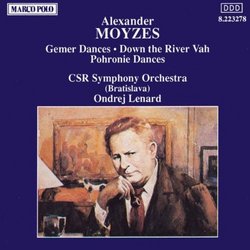Charming music
Russ | Richmond, VA | 10/08/2006
(5 out of 5 stars)
"Alexander Moyzes (1906-1984) is considered to be one of the leading composers of twentieth-century Slovakia. He is primarily known for his twelve symphonies, all of which are available on Naxos' Marco Polo label. The music of Moyzes owes some to Dvorák; and some to Novák perhaps, although I find Moyzes' compositional voice to wholly characteristic. Moyzes makes heavy use of Slovak folk material. In general, his quicker movements are bubbling over with snappy melodic snippets, while the slower movements have a lovely pastoral quality.
On the present release, we have three dance suites for large orchestra. Of course, this isn't profound music (it is not meant to be), but these vividly orchestrated pieces are never less than highly enjoyable. The melodic material is usually based upon a short memorable, melodic phrase. The inspiration for the "Down the River Vah" suite is quite obvious. Before listening to this piece, I couldn't help but wonder how this suite would compare against Smetana's "Moldau." So, I definitely grinned in the first movement when I heard the fluttering of a solo flute symbolizing the trickling of a stream. But the similarities stop there. The music is more extraverted than reflective, and is heavily orchestrated. Moyzes' suite takes the listener from the headwaters in the mountains, through a series of meadows then over a succession of turbulent rapids, before the Vah River reaches the Danube, where the music closes with a powerful and affirmative (emphasized) rendition of the opening theme.
The Gemer Dances are notable for the inclusion of a cimbalom, a hammered instrument part of the dulcimer family (Kodály used this instrument in Hary Janos). The Gemer Dances have a folksy, out-of-doors feel. The lilting, woodwind-colored, opening of the "Hayduks from Kolesne" dance will definitely entice admirers of Dvorák.
Likewise, the Pohronie Dances are brimming with exuberance and charming ideas. I particularly enjoy the "On the Meadow with Flowers" dance, with its mournful pastoral theme introduced by the oboe. Characteristic writing for the oboe, as well as the other the other woodwinds, is a trademark of Moyzes' symphonic writing. Also interesting is the "In the Mountain with Axes" dance theme, which is partially mischievous, but totally enchanting.
In short, check this out if you enjoy vividly orchestrated nationalistic dance suites. That is, if you can find a copy. If you are looking to get acquainted with Moyzes through one of his symphonies, I can highly recommend the release containing the seventh and eighth, or the release containing the ninth and tenth, both on Marco Polo. Moyzes' symphonies are slightly more serious that these orchestral suites (the ninth and tenth are darker works, colored by the Soviet occupation of Czechoslovakia in 1968). However, each of Moyzes' symphonies contains a certain degree of the vibrancy and folk-colorings found in these suites. I truly hope that Naxos decides to re-issue its Moyzes recordings on the "Naxos" label so that a greater population can become acquainted with this attractive music, especially considering that the supply of the Marco Polo discs appears to be dwindling rapidly.
TT: 71:03"


 Track Listings (13) - Disc #1
Track Listings (13) - Disc #1